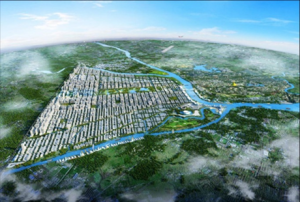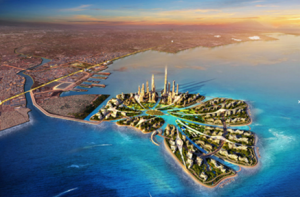Since 2013, the Belt and Road Initiative (BRI) has spread economic benefits across Asia. The BRI, announced under Xi Jinping’s presidency, aimed to improve regional integration, increase trade, and stimulate economic growth. The Digital Silk Road, a significant subset of China’s overall BRI strategy, was launched in 2015 (DSR). The DSR is a subset of BRI that allows participating countries to collaborate on “smart city” development, which includes telecommunication networks, artificial intelligence (AI), cloud computing, e-commerce, mobile payment systems, and other areas of advanced digital technology. However , what does this mean for the BRI projects in participating countries?
To answer the question, flash forward to the first Belt and Road Initiative Forum, which took place in May 2017 in Beijing. President Xi Jinping presented the BRI’s five key goals: policy coordination, facility connectivity, unimpeded trade, financial connectivity, and people-to-people bonds. This demonstrates how the Belt and Road Initiative’s efforts and visions are about more than just venture capital and investments, and they are also about improving people’s lives. President Xi reiterated the importance of the Digital Silk Road in the overall BRI projects on that day, and he called for integrating BRI projects into next-generation network technology (Xinhua, 2017). The BRI and DSR can be viewed as a package to penetrate Internet technologies such as big data and smart cities to efficiently connect landlocked and developing countries to the global economy through inclusive international trade and investment systems among the participating countries.
Highlight the term “smart city”, it is essential to understand the definition behind this emerging term. According to the United Nations, 68% of the world’s population will live in urban areas by 2050 (United Nations, 2019). Cities began to urbanise in response to demographic and economic growth, frequently resulting in problems and challenges such as traffic congestion, poor air quality, deteriorating public services, etc. The smart city concept emerges as a potential solution to the aforementioned urban challenges (Lee et al., 2022). Cities that attempt to adopt the Smart city concept are offered flexibility, which includes a variety of approaches to improve life quality, reduce environmental impacts and increase the sustainability of new city areas. Hence, smart city implementations vary widely depending on the city’s characteristics and current condition.
According to a recent report by an analyst firm, Shanghai is ranked first among the top five Smart Cities (Juniper Research, 2022). Beijing, as the capital of the People’s Republic of China, is also ranked fourth on the top five list. It is now evident how committed China is to successfully develop smart cities. On the other hand, DSR is China’s government’s effort to collaborate with some leading companies. As an example, Kuala Lumpur, Malaysia. Kuala Lumpur has become the first city outside of China to adopt AliCloud’s smart city system. This project enables real-time data collection and integration of traffic and emergency data in real-time from hundreds of traffic cameras and other sources. This improvement increased traffic flow efficiency and allowed traffic signals to respond to emergency vehicle passage (Szewcow & Andrews, 2018). This is an example of one city’s involvement in DSR project with China. This has become valuable action and the right choice to transform cities in participating countries into smart cities, as China is home to some of the world’s most advanced and well-recognised Smart Cities.
To share its experience in developing smart cities, China launched a huge smart city construction project named the City of Pearl in the Philippines in 2017. One promising project for the Philippines’ future is the Manila Bay City of Pearl, which will integrate hardware and software to allow international and local talents from the financial, cultural, educational, and medical sectors to grow and integrate (Salikha, 2018). This project is implemented under the BRI framework of China-Philippines collaboration. Ho & Partners Architects Engineers & Development Consultants Ltd. (HPA) designed the City of Pearl, built by the UAA Kinming Group Development Corporation. This local group has partnered with mainland Chinese companies. According to HPA, these 407 hectares of land is Asia’s biggest self-sustaining smart city. Expected to be completed by 2030, this city planned to host more than 500,000 citizens and create over 100,000 jobs.
New Yangon City (NYC) is another smart city flagship project in Myanmar. This city will be built on 88 square kilometers of land. It will be envisioned as a “Productive City, Liveable City”, with world-class, high-quality infrastructure and transparent delivery and governance. New Yangon City is an expansion of Yangon City, Myanmar’s most densely populated city. Yangon is experiencing some issues due to its rapid urbanisation and ageing infrastructure. By 2050, New Yangon City will be home to 1.2 million population and provide 900.000 jobs (NYDC, 2019).
The information gathered in this article provides only slight evidence, among many others, to discuss the smart city initiative under the DSR. Working on the vision to implement advancement in city development requires much more attention from experts, researchers, societies, and local leaders. As technologies advance, implementing the smart city concept proposes revolutionising city services such as transportation, economic activities, education, and healthcare, among many others. Enhancing collaboration within the local institutions and communities is also critical to implementing any smart city innovation. The technology will only be valuable if it improves the quality of life for every citizen in the city and how the community interacts with one another, or with nature. Digital transformation in urban areas within the smart city is a window to more opportunities and benefits for all levels of society.
BRI projects surround broad improvement sectors in financial trade and the distribution of digital technologies in the participating countries’ cities and regions. Putting visions and ideas into action for the future of development will benefit the whole society and serve as a stepping stone to its actualisation. The DSR has made technological advancement in city services accessible for cities of participating countries. It is evident how BRI strives to provide tangible benefits to participating countries in each project. Smart cities under the DSR projects should not be viewed as a competition to see who can build the “smartest” cities but rather as a chance to reduce global urban inequality.
About the writer:
Muhamad Devandra Adiwinata, Bachelor student in Urban and regional planning, Diponegoro University and knowledge Management Intern at the UCLG ASPAC Secretariat.
References:
Juniper Research. (2022, January 24). World’s No 1 Smart City for 2022: Shanghai. Juniper Research. https://www.juniperresearch.com/press/worlds-no-1-smart-city-for-2022-shanghai
Lee, J., Babcock, J., Pham, T. S., Bui, T. H., & Kang, M. (2022). Smart city as a social transition towards inclusive development through technology: a tale of four smart cities. https://doi.org/10.1080/12265934.2022.2074076
New Yangon development Company Ltd (NYDC). (2019, May 24). New Yangon City: Final Master Plan Report. https://www.nydc.com.mm/master-plan-summary/
Salikha, A. (2018, February 18). The New Manila Bay, World’s Biggest ‘Smart City’ To Rise in Philippines | Seasia.co. https://seasia.co/2018/02/14/the-new-manila-bay-world-s-biggest-smart-city-to-rise-in-philippines
Szewcow, B., & Andrews, J. (2018). Kuala Lumpur to manage city data with Alibaba Cloud. https://news.itu.int/kuala-lumpur-manage-city-data-alibaba-cloud/
United Nations. (2019). World Urbanization Prospects: The 2018 Revision. UN. https://books.google.co.id/books?id=Kp9AygEACAAJ
Xinhua. (2017, May 14). Full text of President Xi’s speech at opening of Belt and Road forum. Ministry of Foreign Affairs of the People’s Republic of China. https://www.fmprc.gov.cn/mfa_eng/wjdt_665385/zyjh_665391/201705/t20170527_678618.html

